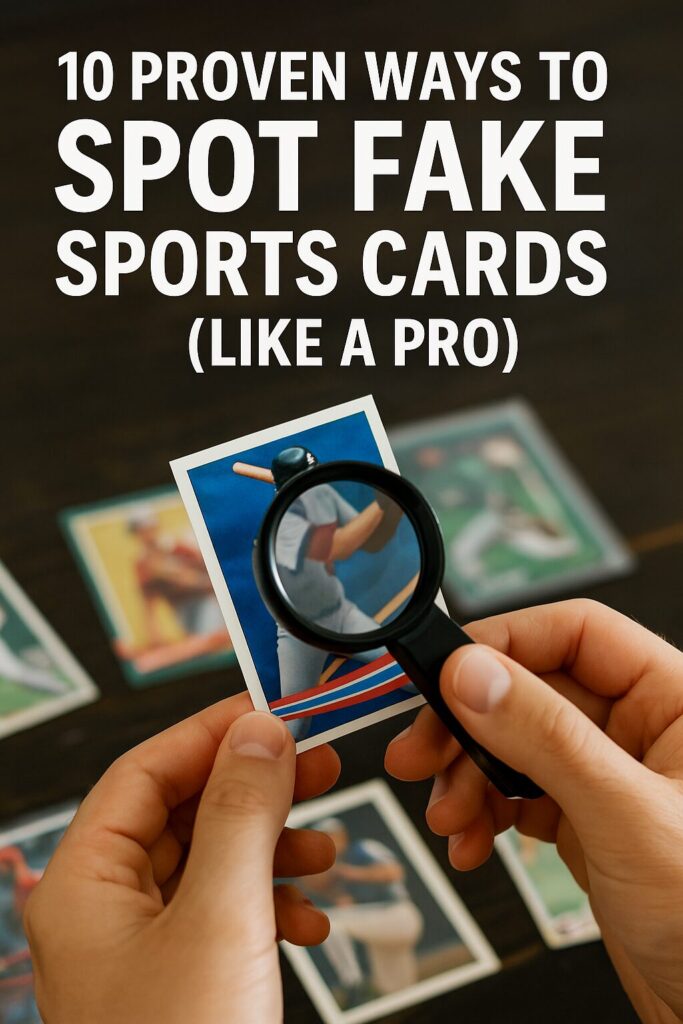
Trying to spot fake sports cards? This guide gives you 10 proven checks—used by collectors and graders—so you can confidently buy, sell, and trade. By the end, you’ll know how to spot fake sports cards fast using light, touch, fonts, serials, and more.
Quick Answer
To spot fake sports cards, examine print quality under light, feel the card stock, check edges and corners, compare fonts and logos to known-authentic examples, verify serial numbers and holograms, and use a loupe or blacklight. When in doubt, get a reputable third-party opinion.
10 Proven Ways to Spot Fake Sports Cards
1) Do the Light Test (Front & Back)
Hold the card at an angle under a bright light. Authentic cards have consistent gloss or matte finishes depending on the set; counterfeits often reflect unevenly or look overly glossy. Use a small flashlight to reveal print patterns and surface tampering—an easy way to spot fake sports cards without tools.
2) Inspect the Print with a Loupe
Use a 10x jeweler’s loupe. Many vintage and modern cards show precise rosette (CMYK) dot patterns. Fakes can look fuzzy, grainy, or show misregistered colors. Edges of numbers and team logos should be razor sharp on real cards.
3) Feel the Card Stock
Gently flex and tap the card. Real Topps, Panini, and Upper Deck stock has a specific stiffness and “snap.” Counterfeits can feel too thin, too stiff, or oddly soft. Texture should match the brand and year—glossed chromium sets (e.g., Prizm) feel different from standard paper stock.
4) Check Corners and Edge Cuts
Factory cuts are clean and consistent. Counterfeits (or trimmed cards) often show micro-chipping, frayed paper fibers, or corners that are “too perfect” for the card’s age. Use a loupe to look for freshly shaved edges.
5) Verify Fonts, Logos, and Layout
Compare to a high-resolution, authentic reference. Counterfeits frequently use slightly wrong fonts, letter spacing, or logo proportions. Player names, team names, and set branding should match exactly. This typography check alone helps you spot fake sports cards quickly.
6) Examine Foil, Holograms, and Stamp Details
Modern releases use complex foils, microtext, or holographic stamps. On real cards, foil is crisp, aligned, and adheres cleanly; on fakes it can be dull, misaligned, or peeling. Serial-number stamping should be uniform in depth and font.
7) Validate Serial Numbers and Parallels
For numbered cards (e.g., “15/99”), make sure the numbering style, placement, and font match other known examples from the same set. Search marketplaces and forums for comparisons. Inconsistent serial formats are a red flag when you try to spot fake sports cards.
8) Compare Colors to Known-Authentic Scans
Skin tones, team colors, and backgrounds should match the set. Counterfeits often print too dark or too saturated. If the card uses special ink (e.g., refractors), the color shift and rainbow effect should look identical to legit copies.
9) Use a Blacklight (UV) Check
Some fakes fluoresce oddly under UV because of modern paper or glue. Authentic vintage stock usually reacts differently than new paper. UV won’t catch everything, but it’s another quick way to spot fake sports cards when combined with other checks.
10) When in Doubt, Get a Pro Opinion
Third-party grading and authentication (PSA, BGS/Beckett, SGC) provide expert verification. High-value purchases are worth a pre-grading review or a submission. Professional opinions reduce risk and help you spot fake sports cards before you spend big.
Common Red Flags
- Too-good-to-be-true prices with vague photos.
- Wrong foil sheen, inconsistent serial fonts, or smeared ink.
- “Perfect” vintage corners that don’t match the rest of the wear.
- Seller can’t provide clear, close-up images on request.
Safe Buying Checklist (Copy & Save)
- Pull a legit reference image of the same card.
- Light test + loupe check (front/back, edges, fonts, logos).
- Confirm serials/stamps and compare foil or holograms.
- Ask for additional photos (angled, macro, back corners).
- Use trusted marketplaces; prefer graded or returnable purchases.
Helpful Resources
- PSA: Resources & Card Facts
- Beckett (BGS): Hobby News & Guides
- SGC: Grading Services
- Topps Official | Panini America | Upper Deck
Explore More on AnswerNimbus
Love collecting? Browse more guides in our Collectibles category. If you enjoy TCGs too, check out our tips for identifying counterfeit cards in that space as well.
FAQ
How can I quickly spot fake sports cards when buying online?
Ask for angled photos, macro shots of fonts/foil, and back-corner closeups. Compare to a known-authentic reference and watch for mismatched fonts, dull foil, or serial inconsistencies—fast ways to spot fake sports cards remotely.
Do graded cards eliminate fakes entirely?
Grading by PSA, BGS, or SGC dramatically reduces risk but isn’t an absolute guarantee. Still, third-party slabs are among the safest options when trying to spot fake sports cards on expensive purchases.
Is a blacklight necessary?
Not required, but helpful. Blacklight can reveal odd paper or glue fluorescence. Use it alongside print, stock, and serial checks for the best chance to spot fake sports cards.
AnswerNimbus is an online knowledge hub providing step-by-step guides, how-to fixes, and clear explanations across technology, home, collectibles, and everyday curiosities. Our mission is to make useful information easy to find, understand, and apply.
